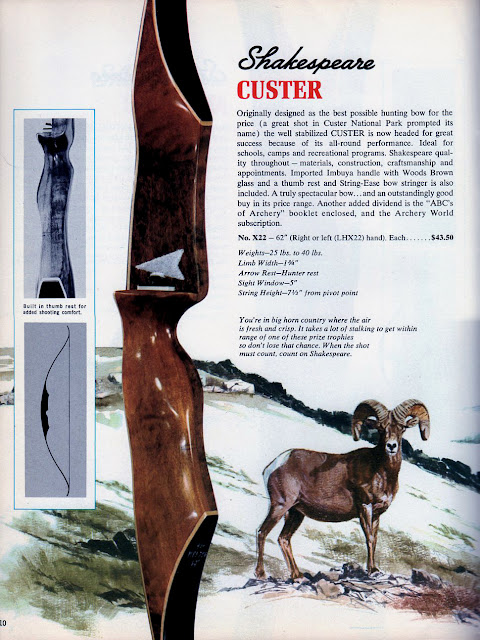 |
| Shakespeare Catalog May 1969 |
Shakespeare Cascade X29
by
Larry Vienneau
Like all Shakespeare
Hunting “X” bows, The Cascade was named after a National Forest area. The former
Cascade National Forest was established by the U.S. Forest Service in Oregon on
March 2, 1907, it is now part of the North Cascades National Park Complex in Washington State. Rich in bio-diversity,
it has been a favorite hunting region and has yielded a wealth of data about
human activity spanning the last 9,600 years.
Cascade X29 1969 – 1972
- 50” AMO
- 2 ½ wide limbs
- Pistol grip Riser, Resin/ wood composite
- Draw weights - 35, 40, 45, 50, 55, 60, 65 lbs.
- Originally it had a 45" string.
- Chronograph Avg. 174.6 feet per second
- Brace height is rather high at 9 inches
- 4 1/2 inch shooting window
- Wood and white glass tip overlays
The Cascade was nicknamed BLACK BEAUTY and was marketed as
the "Broad Bow.” In the late 1960s, there
was a trend toward ever-shorter hunting bows. Shakespeare was pushing the
envelope of technology. It introduced the Cascade which was one of the shortest
bows of the era The Cascade was one the only two bows ever made with 2 1/2" limbs, the other 2 1/2 wide limbed bow was the 52" Root Hunt Master. The
theory was the wide limb requires a thinner limb and would allow for better
weight distribution and result in a smoother draw. A 1969 Shakespeare Ad
claimed it could “handle 25% more stress and deliver 33% more speed than other
short bows.” Its riser is a tournament pistol grip made with “Jet Age” Phenolic laminate Black
Formica impregnated with phenolic thermosetting resins. English translation: the riser material is
made by combining resins and wood particles which were compressed under high
pressure and temperature into dense, uniform material which resembles Ebony.
This was one of the first composite resin risers. I have read that there were
problems with the riser cracking in the first productions but they worked out
the technical issues.
 |
| a beautiful Cascade thanks to Jim Luby |
Some people are
reluctant to try a short bow because they worry about “stacking”. A limb should
increase tension at about 2-3 pounds per inch steadily to be considered smooth.
If a limb produces peak weight too fast it is referred to as stacking. A bow
that “stacks” may draw smoothly at 27- 28 inches, but the tension dramatically
increases over 28”. A short bow stacking results quickly because the limbs
reach their peak quicker at a short draw length.
 |
| My 45# Cascade Wonderbow |
I have a beautiful #47 Cascade which has no noticeable
stacking at all. My draw is 27 ½ inches. I attempted to extend my draw to 30+” by
pulling the string past my ear. I did feel some mild stacking at about 31
inches. I think the Cascade design has effectively diminished the stacking
problem. The bow also has very little hand shock. Some short bows also have
problems with string pinch. This has to do with the steep angle created by a
short bow. I did not experience excessive string pinch. This bow is very fast;
I shot it with my Bear 45# Kodiak Super Magnum and it seemed to deliver the arrows
quicker. I also shot the Cascade with my other Shakespeare bows and it was
sending arrows through the target while the other bows were not showing as much
penetration. I tested its speed and it shoots at nearly 175 FPS. I also tested all of my forty-five vintage bows by shooting three 300 rounds at 20 yards from each bow. The Cascade tied my Pecos X23 as the most accurate shooter. Pecos shot more "X bulls-eyes" so it finished first. Cascade has everything you need from a hunting bow to, a compact design with speed and accuracy!! I think the 1969 Shakespeare Ad wasn’t
advertising hype, the bow does handle the strain of short limbs very well
and it does push arrows at higher velocity. If your draw length is 29 inches I
think this bow will be very comfortable for you to shoot. Tuning the bow is
tricky. It has a high brace height of 8 1/2 - 9 inches and can be loud until you
find your sweet spot. Mine is set at 8 3/4 inches. I also suggest strung silencers to dampen the
sound. I think this will soon be my new
favorite tree stand or blind bow!
 |
| "NEWS / NEW PRODUCT" Archery World May 1969 pp. 79 & 80 |


















